What is cholesterol, and low and high density cholesterol? What is "bad" and "good" cholesterol
In the human body, cholesterol (aka cholesterol) performs important role during metabolism, is part of the structure of many cells of the body. However, there are “good” and “bad” fractions of this element, which affect human health in different ways. With an increase in the amount of cholesterol in the blood, the risk of heart attack and stroke increases.
What are high density lipoproteins
Most of the substance is produced by the body in the liver (about 80%), the remaining share falls on its intake with food. Cholesterol takes part in the formation of hormones, bile acids, cell membranes. The element itself is poorly soluble in liquid, therefore, for transportation, a protein shell is formed around it, which consists of apolipoproteins (a special protein).
This compound is called lipoprotein. Several of its species circulate through the vessels of a person, which turned out to be different due to the different proportions of the elements that make up the composition:
- VLDL - very low density lipoproteins;
- LDL - low density lipoproteins;
- HDL stands for high density lipoprotein.
The latter contain little cholesterol, consist almost of the protein part. The main function of HDL cholesterol is to transport excess cholesterol to the liver for processing. This type of substance is called good, it accounts for 30% of blood cholesterol. The excess of low-density lipoproteins over high-density lipoproteins provokes the formation cholesterol plaques, which, when accumulated in the arteries and veins, lead to a heart attack, stroke.
Blood test for cholesterol
To determine the level of cholesterol, you must pass biochemical analysis blood, which determines the content of HDL and LDL. Research is assigned as part of a lipogram. It is recommended to do it to all people over 20 years of age at least once every 5 years. If the patient is prescribed a low-fat diet, medications, blood tests should be done more often to monitor the effectiveness of therapy.
How to take
Blood test for total cholesterol requires some preparation before delivery. To get the correct indicators, you must follow these rules:
- sampling should be done in the morning;
- limit fatty foods for 2-3 days before the procedure;
- last appointment food should be 8 hours before the test;
- avoid physical activity, emotional overstrain;
- stop smoking at least 30 minutes before the test.
Decryption
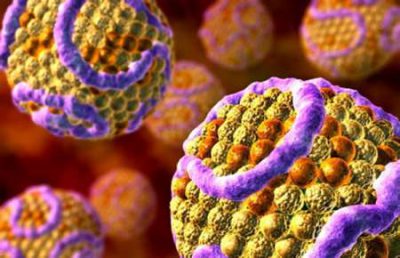
The results of the analyzes show the total amount of cholesterol in the blood, the content of triglycerides, which affect lipid processes, and HDL, LDL. We can say that the ratio of bad and good cholesterol determines the likelihood of developing vascular disease. This value is called the atherogenic index or coefficient. Otherwise, there is a specific list of indicators of the level of LDL and HDL in the blood of women, men different ages:
| LDL cholesterol, mmol/l | HDL cholesterol, mmol/l |
|||
The coefficient of atherogenicity is increased
Such a conclusion, when deciphered, indicates the likelihood of developing heart disease, cholesterol plaques, narrowing of the lumen of blood vessels, which leads to stroke, heart attack. In this case, "bad" cholesterol prevails over "good". To calculate the atherogenic coefficient, you need to subtract HDL cholesterol from the total amount of HDL cholesterol and divide the result once again by the HDL level. The reason for the development increased rate becomes:
- severe liver disease;
- heredity;
- kidney failure(chronic);
- undertreated diabetes;
- cholestasis;
- inflammation of the kidneys chronic form leading to nephrotic syndrome.
The coefficient of atherogenicity is lowered
it good news, in this case, the risk of developing cholesterol plaques, blockages, heart attack or stroke is extremely small. This fact does not carry any diagnostic value and means that there is high cholesterol HDL, which does not pose any danger to human health. During treatment, they always try to bring the atherogenic index to normal or lower it.
Norm HDL
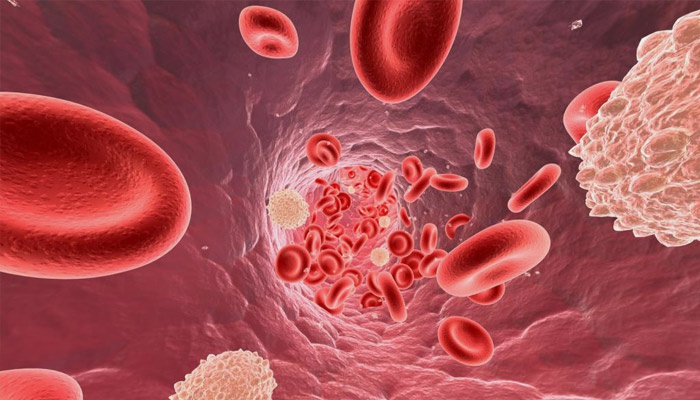
Normal in relation to good cholesterol is not correct wording. The acceptable level of this fraction varies from case to case and is determined individually for a person. The likelihood of developing diseases of the cardiovascular system is influenced by many factors that should be studied individually for each patient. Low HDL cholesterol levels definitely cause the risk of atherosclerosis. According to general statistics, it is possible to assess the risk of development in adults according to the following indicators:
- A high probability of developing atherosclerosis in men at 10 mmol/l, in women - 1.3 mmol/l, without taking into account concomitant factors.
- The average probability of atherosclerosis will be 1.0-1.3 mmol/l in men and 1.3-1.5 mmol/l in women.
- A low probability of atherosclerosis in humans will be at 1.55 mmol / l.
How to increase good cholesterol if HDL is low
AT different periods a person may have different percentage HDL cholesterol. Therefore, a single blood test is not an indicator of the "usual" amount of cholesterol. This suggests the need to check the level of the substance regularly in case of fear of an increase. Changes can occur over a short period of time, this is called fluctuations in cholesterol metabolism. To increase HDL, you should:
- exclude corticosteroids, anabolic steroids, androgens;
- avoid stressful situations;
- take statins, fibrates, cholestyramine, phenobarbital, insulin, estrogen.
Learn more about how to take an analysis.
Video about bad and good cholesterol
When conducting a biochemical blood test to determine the level of cholesterol, it is important to establish not only the general indicator of this substance, but also the concentration of low and low lipoproteins. high density. Even if the level of total cholesterol is normal, too low HDL can lead to the development of diseases that affect the cardiovascular system.
What are high density lipoproteins and their functions
Cholesterol (also known as cholesterol) is present exclusively in the bodies of humans and animals. Plants do not contain this substance. It can be found in the liver, adipose tissue, adrenal glands, brain/spinal cord. Cholesterol is important elements cell membranes.
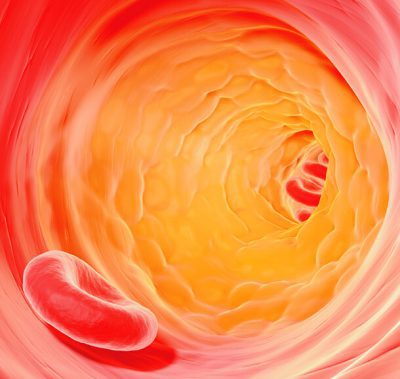 Cholesterol is involved in the production of hormones and protects the cells of the human body from the action of external factors. This is an extremely important substance necessary for the normal functionality of the body. Among other things, cholesterol is also responsible for the production of vitamin D, the primary source of which is sunlight.
Cholesterol is involved in the production of hormones and protects the cells of the human body from the action of external factors. This is an extremely important substance necessary for the normal functionality of the body. Among other things, cholesterol is also responsible for the production of vitamin D, the primary source of which is sunlight.
About three hundred and fifty grams of the substance is present in the human body. About ninety percent of cholesterol is found in the tissues, the remaining ten - in the blood. Most of the substance (about eighty percent) is synthesized by the liver. The remaining twenty percent enter the body with food (meat, fish).
Cholesterol is insoluble in water. Therefore, it is not able to independently circulate through the bloodstream. In the human body, cholesterol is found in compounds with special proteins. Today, there are several types of such compounds:
HDL is synthesized in small quantities in small intestine. But here the so-called "immature lipoprotein" is formed. This substance, before entering the bloodstream, passes through the liver, in which the main part of high-density lipoproteins is formed.
In addition to transporting cholesterol from tissues and organs to the liver, HDL performs the following functions:

Thus, cholesterol plays an important role in the normal functioning of the human body. It is carried along it in combination with proteins, forming lipoproteins. A special role is played by high-density lipoproteins (alpha is another designation for this cholesterol). They are responsible for removing excess cholesterol from the cardiovascular system. In addition, this compound is involved in many important processes for the functioning of the body.
Indicators of cholesterol in the blood
In order to establish what level of cholesterol in the bloodstream, it is necessary to conduct a biochemical analysis. Since cholesterol is found in food, eating twelve hours before the blood sampling procedure can distort the result of its analysis. Therefore, it is carried out in the morning, on an empty stomach. Before this, the person from whom blood is taken must exclude food intake, starting from seven o'clock in the evening of the previous day.
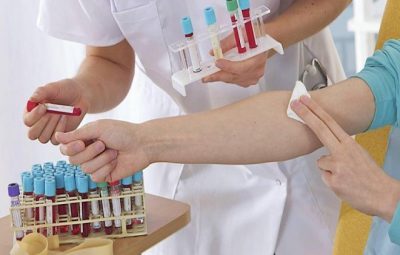 The need for such a study arises if a person has:
The need for such a study arises if a person has:
- atherosclerosis;
- diseases affecting the liver;
- diseases of the cardiovascular system. Analyzes are carried out with coronary artery disease and myocardial infarction. Thanks to the study, the specialist will be able to assess the risk of complications and predict further development illness.
Feedback from our reader - Olga Ostapova
I was not used to trusting any information, but I decided to check and ordered one package. I noticed changes within a week: my heart stopped bothering me, I began to feel better, strength and energy appeared. Analyzes showed a decrease in CHOLESTEROL to NORM. Try it and you, and if anyone is interested, then below is a link to the article.
The purpose of the analysis is to determine the following indicators:
- the level of total cholesterol;
- concentrations of LDL and HDL in the bloodstream;
- determination of the coefficient of atherogenicity.
What is the coefficient of atherogenicity? This is a particularly important indicator that displays the ratio between the concentration of LDL and HDL in the bloodstream. If this ratio is greater than three to one, there is a risk of atherosclerosis.
The established standards make it possible to assess the level of total cholesterol in the blood and the concentration of high density lipoproteins. Specific boundary norms depend on the sex of the subject and his age. The norm is the concentration of ABL cholesterol (HDL) not lower than 0.90 mmol per liter (for men). For women, this figure is higher - at least 1.15 mmol per liter.
You can learn more about the boundary norms of "good" cholesterol, depending on the age of the subject, from the following table.

Although in the table provided, the lower cholesterol value in some cases drops to 0.78 mmol per liter, the level of a substance below 1 mmol per liter increases the risk of developing diseases associated with the cardiovascular system.
So, the risk of developing coronary disease heart increases by twenty-five percent with a decrease in the concentration of a substance in the bloodstream relative to the average by 0.13 mmol per liter. With an HDL value below 0.78 mmol per liter, the likelihood of atherosclerosis increases three times. An HDL level above 1.56 mmol per liter is considered an anti-atherogenic factor that provides protection against diseases that affect the cardiovascular system.
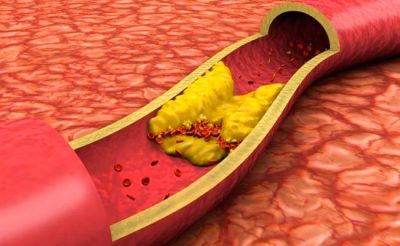 The coefficient of atherogenicity mentioned earlier is also important. Today, the following standards have been established for this indicator:
The coefficient of atherogenicity mentioned earlier is also important. Today, the following standards have been established for this indicator:
- less than 1 - for newborns;
- up to 2.5 - for men from twenty to thirty years old;
- up to 2.2 - for women of the same age;
- up to 3.5 - for men aged from forty to sixty years.
The lower this indicator, the better. If these values are exceeded, the risk of developing atherosclerosis increases. So, with a coefficient of three to four, there is a moderate probability of the appearance of the disease. A value above four is a high probability.
Thus, the level of HDL directly affects the risk of developing diseases associated with the cardiovascular system. With an indicator of high density lipoproteins below 1 mmol per liter, the likelihood of developing atherosclerosis and coronary heart disease increases. An HDL level above 1.56 mmol per liter significantly reduces the chance of these diseases.
Causes and danger of changes in HDL in the blood
The reason for the change in the level of high density lipoproteins and their concentration beyond the established norms can be both diseases and certain medications, as well as other factors. A decrease in HDL levels can be caused by:
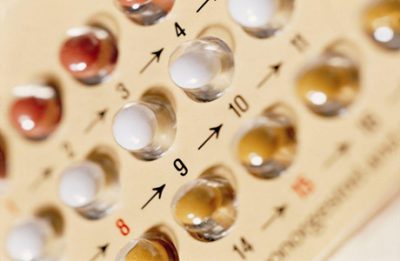
High density cholesterol performs a protective function in relation to cardiovascular system. Too much low level this substance leads to an excess of "bad" cholesterol (LDL, aka ZBL cholesterol), which can provoke the development of the following diseases:
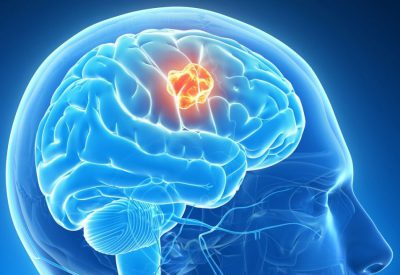
All of the diseases described above pose a serious threat human body. In the absence of timely treatment, they can be fatal.
Thus, the main function of HDL is the transport of cholesterol from cells to the liver. Solving the problem of excessive concentration of cholesterol in the body, HDL cholesterol performs a protective function. There are established standard norms for this substance. The only way to find out the concentration of HDL in the bloodstream - to carry out a biochemical blood test. Too low concentration of this substance is dangerous for the body. This leads to the development of diseases that affect the cardiovascular system. Lack of therapy can be fatal.
DO YOU STILL THINK IT'S IMPOSSIBLE TO FULLY HEAL?
Have you been suffering for a long time from constant headaches, migraines, severe shortness of breath at the slightest load, and plus pronounced HYPERTENSION? Did you know that all these symptoms indicate ADVANCED LEVEL CHOLESTEROL IN YOUR BODY? And all that is needed is to bring cholesterol back to normal.
Judging by the fact that you are now reading these lines, the fight against pathology is not on your side. Now answer the question: does it suit you? Can all these symptoms be tolerated? And how much money and time have you already "leaked" for ineffective treatment of SYMPTOMS, and not the disease itself? After all, it is more correct to treat not the symptoms of the disease, but the disease itself! Do you agree?
Cholesterol is one of the most important substances for any living being belonging to the animal kingdom. This fatty monohydric alcohol is one of the natural intermediate products of metabolic processes.
At the same time, it is cholesterol that is considered one of the "culprits" of atherosclerosis and some other diseases. After the discovery of the role of this substance in pathophysiological processes, cardiologists, nutritionists, and doctors of some other specialties took up arms against him. In fact, everything is not so simple and unambiguous, the trouble is not in cholesterol, as such, but in its quantity and the body's ability to absorb this substance properly.
About 80% of the need for this substance is provided by the body on its own, cholesterol is synthesized in the liver. The rest of the body receives from food of animal origin. It enters the blood in the form of complex complex compounds and is included in a number of processes, in particular:
- Growth and reproduction of cells, as one of the components of cell membranes and intracellular structures;
- Synthesis of hormones;
- Transportation of substances with antioxidant activity and fat-soluble vitamins;
- Synthesis of bile acids.
What is "bad" and "good" cholesterol
Cholesterol is insoluble in water, therefore, for transportation to target organs, it forms complex lipoprotein complexes. The complex has a spherical shape and consists of cholesterol esters and triglycerides coated with protein molecules.
There are several types of lipoprotein complexes in the blood, differing in composition and other physical and chemical properties. One of key features lipoprotein complex - density. On this basis, the complexes are just divided into “bad” and “good” cholesterol.
Low-density lipoprotein complexes are abbreviated as LDL and conventionally called "bad" cholesterol. High-density lipoproteins or HDL are called "good".
In fact, both LDL and HDL cholesterol are vital to keep the body functioning.
"Bad" cholesterol
As part of LDL, this compound comes from the liver to target organs, where it is included in the synthesis processes. LDL are the precursors of many hormones, including sex hormones. The body's need for readily available cholesterol is higher, so LDL accounts for over 60% of all cholesterol present in the blood. The content of cholesterol derivatives in them reaches 50%. When moving in the bloodstream, loose complexes can be damaged and cholesterol esters, which are outside the protein coat, settle on the walls of blood vessels.
With excessive intake of LDL into the blood, the cells do not have time to absorb it completely, and the process of deposit formation on the walls of blood vessels accelerates. Atherosclerotic plaques form. The narrowing of the lumen of the vessels over time is manifested by vascular insufficiency, ischemia in the affected area. With the destruction of the plaque, a complete overlap of the lumen of the vessel is possible - thrombosis or thromboembolism.
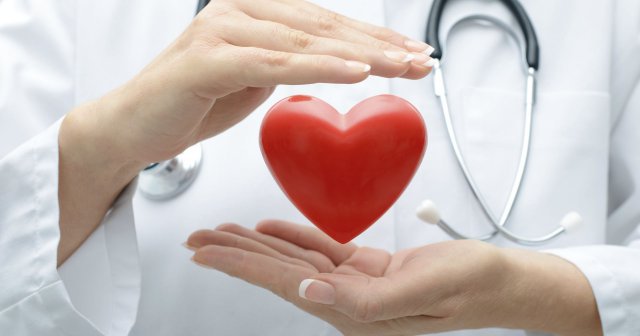
"Good" cholesterol
“Good” is popularly called high-density cholesterol complexes, HDL. These compounds transport cholesterol to the liver, where it is used to synthesize bile acids and excreted from the body. The content of cholesterol in the complexes is up to 30%. In people with a normal content of this fraction of lipids in the blood, the risk of myocardial infarction is reduced to almost zero. When moving through the bloodstream, HDL captures excess cholesterol from the walls, according to some reports, even from plaques formed. If HDL cholesterol is lowered, the body cannot cope with the cleansing of the walls of blood vessels, cholesterol continues to accumulate and atherosclerosis develops.
At the same time, it should be understood that the names "bad" and "good" cholesterol are more than arbitrary. What is HDL cholesterol? In fact, it is one of the final stages of lipid metabolism, “construction debris”, which, before being disposed of, should serve the body in good stead. Replacing all the "bad" cholesterol with good is impossible and unsafe. The main thing is not so much the absolute indicators of the content LDL cholesterol and HDL, and their balance.
Norm of cholesterol in the blood
“Bad” and “good” cholesterol are not interchangeable compounds, they must always be present in the body, simultaneously and in a certain ratio. Deviation from the norm in the direction of increasing or decreasing the content of any of the fractions of cholesterol or any of its fractions indicates the presence serious problems in the body or a potential threat of their occurrence in the foreseeable future.
Approximate levels of cholesterol:
- General - less than 5.2 mmol / l
- Triglycerides - no more than 2 mmol / l;
- LDL - up to 3.5 mmol / l
- HDL - more than 1.0 mmol / l
The concept of a norm is rather conditional. Cholesterol levels depend on gender, age, the presence of endocrine and other chronic disease, hereditary features lipid metabolism. This indicator is influenced by stress, physiological changes seasonal nature. The individual norm may differ slightly from the average values; in the presence of certain diseases and other risk factors, it is necessary to control cholesterol levels more strictly.
About the individual norm and acceptable limits for each patient will tell the attending physician. He will give recommendations for effective lowering of cholesterol levels and, if necessary, prescribe treatment.
How to normalize cholesterol
First of all, doctors recommend to adhere to special diet. Foods containing trans fats are excluded from the diet, the consumption of animal fats and sweets is limited. It is better to replace fatty meat with fatty sea fish, which contains omega-3 and omega-6 polyunsaturated fatty acid.
If necessary, the doctor will prescribe drug treatment. The course of treatment includes:
- statins;
- Bile acid binders;
- Fibric acids;
- B vitamins, vitamin E, omega-3 fatty acids, folic acid.
Patients at high risk of developing cardiovascular disease are often ordered to test for HDL. What it is? This is what high-density lipoproteins are called. chemical compounds cholesterol with proteins. HDL transports cholesterol not from the liver to the tissues, like low-density lipoproteins, but rather back to the liver, where it breaks down into fatty acids and prepares to leave the body.
High-density cholesterol is considered “useful”, since it is involved in the elimination of excess cholesterol in tissues (including in vessels with atherosclerosis) and its natural excretion from the human body. This means that a lack of HDL poses a risk of developing cardiovascular pathologies (in particular, the risk of atherosclerotic plaques).
Norm HDL
There is no need to talk about a specific indicator of the norm, since the values \u200b\u200bare significantly different depending on the age group and gender of the patient. In children, the level of HDL is lower and, on average, is set at positions from 0.78 to 1.68 mmol / l. As for older people, their indicators can normally rise to 0.78 - 2.28. “Good” in most cases is considered to be above 1 mmol / l, but again, the characteristics may vary depending on a number of factors.
In women after 50 years, the level of high-density lipoprotein increases significantly and constantly remains higher than in men. This is considered normal.
Some features of the analysis for HDL
The material for the study is considered to be blood serum obtained during sampling. venous blood(most often from the veins of the elbow bend of the arm). In order to avoid wrong result analysis, it is necessary to exclude fatty foods from the diet, especially of animal origin, in a few days. For some time before the diagnosis, avoid excessive physical exertion and emotional overstrain. In addition, it is not recommended to smoke for half an hour before the study.
Blood sampling is carried out strictly on an empty stomach, it is necessary to exclude food 12 hours before the examination.
Causes of changes in HDL levels in the human body
The level of high-density lipoprotein in the blood can vary significantly depending on the diet, bad habits and rhythm of the patient's life. Pathological causes lowering HDL are:
- disease endocrine system, in particular diabetes mellitus;
- defeat coronary arteries(vessels of the heart);
- stones in the gallbladder;
- pathologies of the liver and kidneys - nephrotic syndrome, chronic renal failure, cirrhosis, hepatitis;
- hyperlipoproteinemia of the fourth type, hypertriglyceridemia;
- acute infectious diseases;
- hereditary diseases (for example, Tangier's disease - a genetic pathology in which metabolism is disturbed).
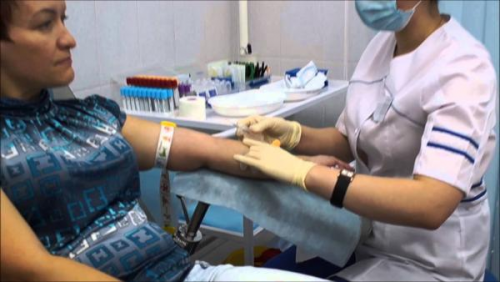
The level of HDL can be lowered due to the intake of a number of medicines: diuretics, beta-blockers, hormonal drugs(androgens, progesterone). Results can be affected by severe stress and recent infectious diseases. In these cases, a minimum of a month and a half is expected to conduct the study.
Why can high-density lipoprotein levels be elevated? Very often this phenomenon is associated with intoxication of the body, including alcohol poisoning. In other cases, HDL may increase due to:
- chronic liver diseases;
- heavy physical exertion;
- hereditary predisposition;
- alcoholism;
- biliary cirrhosis of the liver, etc.
In some cases, the rates increase due to medication treatment: Phenobarbital and other antiepileptic drugs, estrogen, drugs with nicotinic acid. An increase in HDL levels is also observed during pregnancy.
When is it necessary to do a systematic analysis?
In the presence of a number of risk factors, it is worth assessing the level of lipoproteins constantly, making sure that it remains within the normal range. These factors include malnutrition (or vice versa, some therapeutic diets), hypertension, previous myocardial infarction or stroke, history of coronary artery disease and diabetes mellitus, obesity, smoking and alcoholism, decreased physical activity.
It is recommended to have a blood test for HDL more often for patients older than 45 (for men) and 55 (for women) years. If a family member under 55 years old (for the stronger sex) or 65 years old (for the fair half) had a heart attack or stroke, it is extremely important to inform the attending physician about this in order to determine the necessary frequency of the study. Similarly, children from 2 to 10 years old should be tested for high-density lipoproteins if their parents or close relatives suffered from high "bad" cholesterol.
How to increase HDL levels?
First of all, it is necessary, if possible, to exclude risk factors for the occurrence of cardiovascular pathologies. Of course, heredity cannot be avoided, but you can give up smoking and alcohol, engage in more useful species sports - swimming, aerobics, therapeutic exercises.
It is also worth reviewing your diet. It is best to exclude harmful products, especially those that contain a lot of animal fats. Such dishes are replaced with healthy ones: yogurt, white bread, vegetables, legumes, potatoes, natural juices. It is very important to include in the diet oily fish(salmon, tuna, sardines, herring, sea bass or mackerel), which has high content Omega-3 acids, which positively affect the state of the body as a whole and help restore HDL levels. To improve the condition, it is necessary to eat fish dishes at least 2 to 3 times a week.
Remember that only a qualified specialist can correctly evaluate the results of a blood test for HDL and give comprehensive recommendations on further treatment and lifestyle. Do not self-medicate, value your health!
High density lipoproteins circulate in the blood plasma. Their main property is anti-atherogenic. It is these lipoproteins that protect blood vessels from the deposition of atherosclerotic plaques on their walls. For this property, they (HDL) are called good cholesterol, as they also remove excess cholesterol, transporting it to the liver. Some patients are concerned that HDL cholesterol levels are elevated on blood tests. This is especially true for people with problems in the cardiovascular system, in particular, those with a high risk of developing atherosclerosis.
HDL provide the processing and removal of fats from the body, so they are called good cholesterol
The content of LDL and total cholesterol is also evaluated. It is important to know due to which fractions of lipoproteins the level of cholesterol is increased, or what it consists of at its normal numbers.
To determine the value of both cholesterol and lipoproteins of different densities, blood is taken from a vein in the morning, on an empty stomach. According to the results laboratory tests a lipid profile is formed containing the concentration in the blood of total cholesterol, high, low and very low density lipoproteins, as well as triglycerides. All indicators are analyzed first independently of each other, and then in aggregate.
Differences between HDL, LDL and VLDL
To understand the topic, first of all, it is worth learning what atherosclerosis is. Scientifically, this is a vascular disease caused by a violation of lipid and protein metabolism, which is accompanied by the accumulation of cholesterol and some fractions of lipoproteins in the lumen of the vessels in the form of atheromatous plaques. Simply put, these are deposits of cholesterol and some other substances in the vessel wall, which reduce its throughput. Consequently, blood flow becomes worse. Up to a complete blockage. In this case, the blood does not enter the organ or limb and necrosis develops - necrosis.
Deposits of cholesterol and lipids in the walls of blood vessels lead to atherosclerosis.
All lipoproteins are spherical formations of varying density, freely circulating in the blood. Very low-density lipids are so large (of course, on a cell scale) that they are unable to penetrate the vessel wall. Accumulation does not occur and the atherosclerosis described above does not develop. But it is worth remembering that if they are increased, then the development of pancreatitis, a disease of the pancreas, is possible.
Just low-density lipids are able to penetrate the vessel wall. Moreover, when the body tissues need them, lipids pass through the artery further, as they say, “at the address”. If there is no need, and the concentration in the blood is high, then LDL penetrate the wall and remain in it. Further, undesirable oxidative processes occur, which are the cause of atherosclerosis.
HDL is the smallest of the listed lipids. Their advantage lies in the fact that they can easily both penetrate the vessel wall and leave it easily. In addition, they have an antioxidant effect, inhibiting the process of transformation of low-density lipids into atherosclerotic plaques.
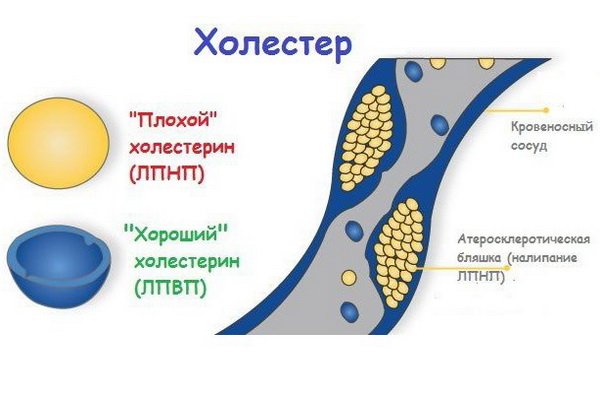
LDL cholesterol is considered “bad”, because when it is in excess, plaques appear in the walls of blood vessels, which can limit the movement of blood through the vessel, which threatens atherosclerosis and significantly increases the risk of heart disease (coronary disease, heart attack) and stroke
Now it becomes clear why high-density lipids are usually called good or useful cholesterol. It also becomes clear why it is worth assessing not only total cholesterol, but also its fractions.
However, do not panic when reading the above mechanism. This does not mean that plaques are constantly formed in the vessels, and their subsequent blockage is only a matter of time. Normally, the mechanisms of lipid regulation work constantly. Only with age, in the presence of an unhealthy lifestyle or with various pathologies this process is violated. Accumulation does not happen all at once, in a matter of minutes or hours, but rather for a long time. But you should not delay treatment.
Reasons for the increase and decrease in HDL
We can safely say that a low level of these lipoproteins is more dangerous than a high one. If HDL is elevated in a blood test, their increase is regarded as protection against atherosclerosis, an anti-atherogenic factor. Undoubtedly, under certain circumstances, overestimated figures of this indicator can cause concern, with too high figures, high density lipoproteins lose their protective properties.
An increase in HDL levels is not dangerous!
The reasons for increasing the level of this fraction of lipoproteins are as follows:
- Genetic mutations that result in overproduction or decreased excretion of good cholesterol.
- Chronic alcoholism, especially at the stage of liver cirrhosis.
- Primary biliary cirrhosis.
- Hyperthyroidism.
- Reception of some medicines: insulin, glucocorticoids.
- Familial hyperalphapipoproteinemia. It is not accompanied by any symptoms, nothing bothers the patient, it is detected as an accidental finding.
- Perhaps an increase in the rate in women preparing to become a mother. This is especially true for later dates pregnancy, when the rate can almost double.

High cholesterol during pregnancy is due to the fact that in the body there is an increase in lipid metabolism and the synthesis of hormones by the adrenal glands.
The reasons reduced content HDL:
- Diabetes.
- Hyperlipoproteinemia type IV.
- Diseases of the kidneys and liver.
- Acute viral and bacterial infections.
You need to understand that one indicator of HDL is not proof of one or the state of the body. It can only be taken into account in comparison with the level of total cholesterol and LDL.
This is expressed, first of all, in the so-called atherogenic coefficient. It is calculated according to the following formula: high-density cholesterol is subtracted from total cholesterol, and then the resulting figure is divided again by HDL. The resulting coefficient is compared with normal values. On average, it should not be higher than 2.5-3.5 for men (depending on age) and no higher than 2.2 for women. The higher the ratio, the higher the risk of coronary heart disease. By including simple mathematical logic, one can understand that the higher the total cholesterol and the less lipoproteins, the more the value of the coefficient will increase; and vice versa. Which again proves the protective function of high-density proteins. Therefore, if both cholesterol and HDL are elevated, this means that in general the coefficient will be low, but it is worth thinking about reducing the cholesterol content in the blood. If only HDL is elevated, this means that there is no cause for concern.
It is impossible to correlate proteins of high and low density through any coefficient. They are evaluated independently of each other.
What can be done
If the reasons for the increase in high-density lipoproteins remain unknown and there is concern for your health, then you should visit your doctor. This is true if blood was donated, for example, as part of a medical examination or for some other reason not directly related to going to the doctor about problems with the cardiovascular system.
Do not worry if the doctor prescribes additional methods examinations. They are needed only for a comprehensive study of the causes of changes in blood parameters.
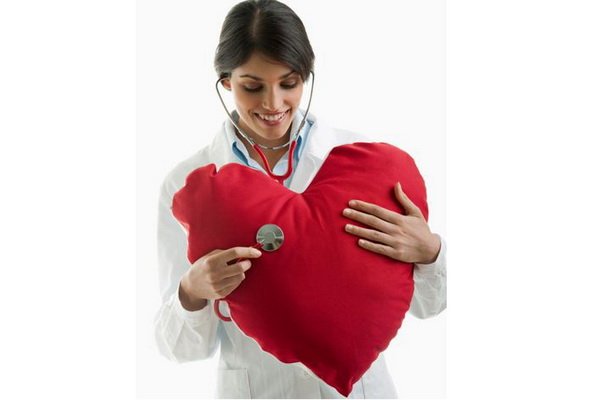
Two weeks prior to the study, lipid-lowering drugs should be discontinued unless the goal is to determine the effect of therapy with these drugs in the analysis.
The doctor's recommendations will contain simple, but very important remarks. To begin with, you should limit the intake of fats, in particular, saturated fats contained in butter, lard, lamb fat, margarine and a number of other products. They should be replaced with polyunsaturated fats, which include olive oil, salmon fish and others. If you are overweight, you should lose it. This is achieved by adjusting the diet and increasing physical activity. Try to stop drinking too much alcohol and stop smoking completely.
In the event that the indicators go far beyond allowable norms, then it can be assigned drug therapy. But its effectiveness will be many times higher also if the above recommendations are followed.
An increase in the level of cholesterol in the blood, as well as its individual fractions, at first glance, may seem dangerous. But do not worry and panic ahead of time.
